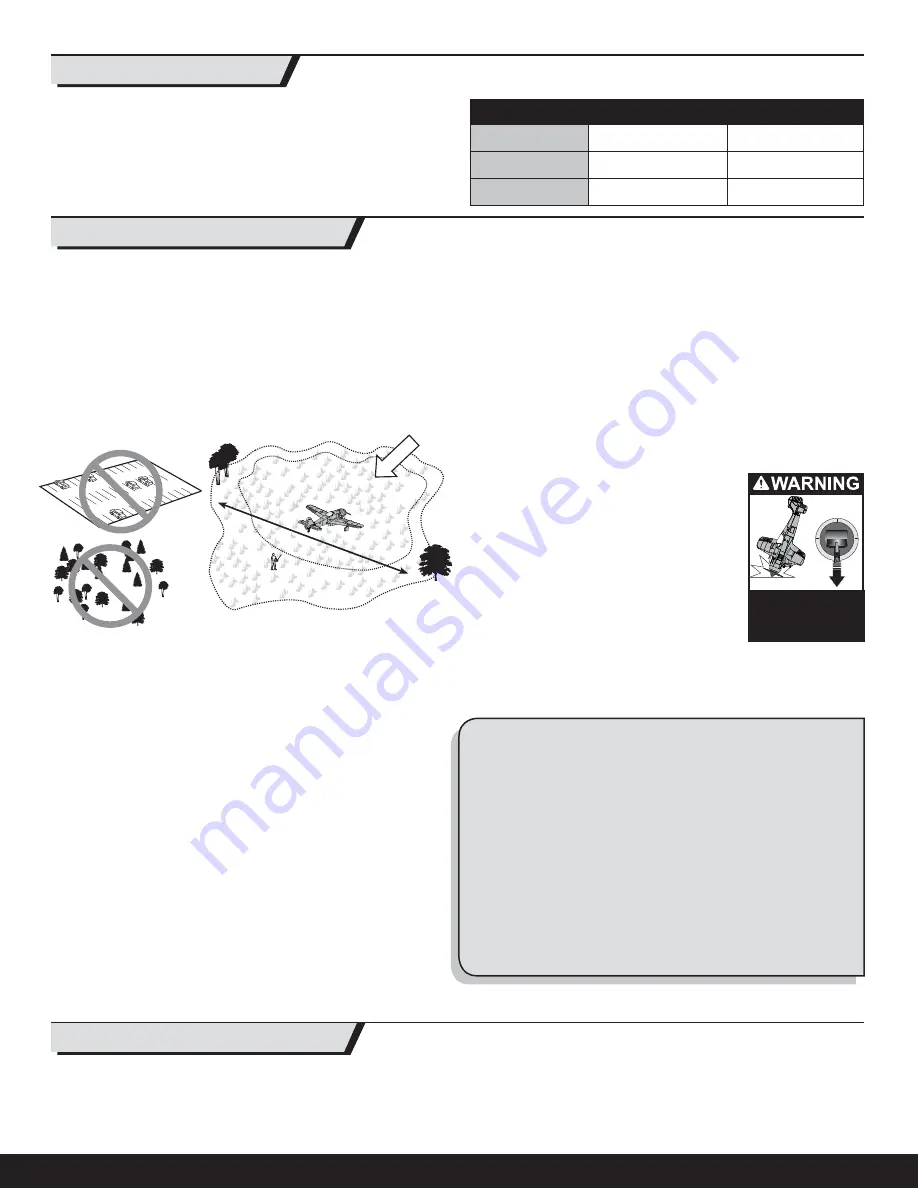
EN
Dual Rates
Your DSM2/DSMX full range transmitter features dual rates to help you select
the amount of travel that you want from the control surfaces.
High Rate
Low Rate
Aileron
12mm up/down
8mm up/down
Elevator
10mm up/down
8mm up/down
Rudder
25mm left/right
20mm left/right
Always
decrease throttle at
propeller strike.
Consult local laws and ordinances before choosing a fl ying location.
Range Check your Radio System
After fi nal assembly, range check the radio system with the aircraft. Refer to
your specifi c transmitter instruction manual.
Flying
Always choose a wide-open space for fl ying your aircraft. It is ideal for you to
fl y at a sanctioned fl ying fi eld. If you are not fl ying at an approved site, always
avoid fl ying near houses, trees, wires and buildings. You should also be careful
to avoid fl ying in areas where there are many people, such as busy parks,
schoolyards, or soccer fi elds.
Belly Landing
If landing on grass without the landing gear, use the same approach as if fl ying
with landing gear. Start your fl are with the power off about 1 foot (30cm) above
the ground and hold the nose up until the tail touches down. Try to keep the
wings level to prevent clipping a wing on the ground and turning the
aircraft sideways.
NOTICE:
For belly landing, remove the cannons, payload and support frame
from the wing or damage to the aircraft may result.
Takeoff
Start the takeoff using rudder to keep the aircraft straight. As the aircraft
reaches fl ying speed, apply a slight amount of up elevator and the aircraft will
fl y off the ground. Avoid forcing the aircraft into the air. Climb to check trim.
Once the trim is adjusted, you can begin to explore the fl ight envelope of the
aircraft.
Landing
Flight times of 7 minutes or more are achievable if using proper throttle
management.
For your fi rst fl ights, set your transmitter timer or a stopwatch to
5 minutes
.
Adjust your timer for longer or shorter fl ights once you have fl own the model.
If the motor pulses, land the aircraft immediately and recharge the fl ight bat-
tery. It is not recommended to fl y the battery to Low Voltage Cutoff (LVC).
To land the aircraft, fl y the aircraft down to the ground using 1/4 –1/3
throttle to allow for enough energy for a proper fl are. The aircraft is easiest to
land doing a wheel landing (two point), where the aircraft touches down on the
main landing gear fi rst while the tailwheel is still off the ground. The aircraft
can also be landed in a three-point attitude, where all three wheels touch
down at the same time. When the aircraft touches down, reduce back pressure
on the elevator stick to prevent the plane from becoming airborne again.
If landing on grass, it is best to hold full up elevator after touchdown and when
taxiing to prevent nosing over.
Once on the ground, avoid sharp turns until the plane has slowed enough to
prevent scraping the wingtips.
NOTICE:
If a crash is imminent, reduce the throttle and trim fully. Failure to do
so could result in extra damage to the airframe, as well as damage to the ESC
and motor.
NOTICE:
Crash damage is not covered under warranty.
NOTICE:
When you are fi nished fl ying, never keep the
aircraft in the sun. Do not store the aircraft in a hot,
enclosed area such as a car. Doing so can damage
the foam.
Repairs
Thanks to the Z-Foam™ construction of this aircraft,
repairs to the foam can be made using virtually any
adhesive (hot glue, regular CA, epoxy, etc). When parts
are not repairable, see the Replacement Parts List for
ordering by item number. For a listing of all replace-
ment and optional parts, refer to the list at the end of this manual.
NOTICE:
Use of CA accelerant on your aircraft can damage paint. DO NOT
handle the aircraft until accelerant fully dries.
Low Voltage Cutoff (LVC)
When a Li-Po battery is discharged below 3V per cell, it will not hold a charge.
The ESC protects the fl ight battery from over-discharge using Low Voltage
Cutoff (LVC). Before the battery charge decreases too much, LVC removes
power supplied to the motor. Power to the motor pulses, showing that some
battery power is reserved for fl ight control and safe landing.
Disconnect and remove the Li-Po battery from the aircraft after use to prevent
trickle discharge. Charge your Li-Po battery to about half capacity before stor-
age. During storage, make sure the battery charge does not fall below 3V
per cell. LVC does not prevent the battery from over-discharge during storage.
NOTICE:
Repeated fl ying to LVC will damage the battery.
Tip:
Monitor your aircraft battery’s voltage before and after fl ying by using a
Li-Po Cell Voltage Checker (EFLA111, sold separately).
1. Disconnect the fl ight battery from the ESC (Required for Safety
and battery life).
2. Power OFF the transmitter.
3. Remove the fl ight battery from the aircraft.
4. Recharge the fl ight battery.
5. Repair or replace all damaged parts.
6. Store the fl ight battery apart from the aircraft and monitor the
battery charge.
7. Make note of the fl ight conditions and fl ight plan results, planning for
future fl ights.
Fly in this area
Stand here
600
feet (182.8 m)
Wind
Maintenance After Flying
Flying Tips and Repairs
12






































